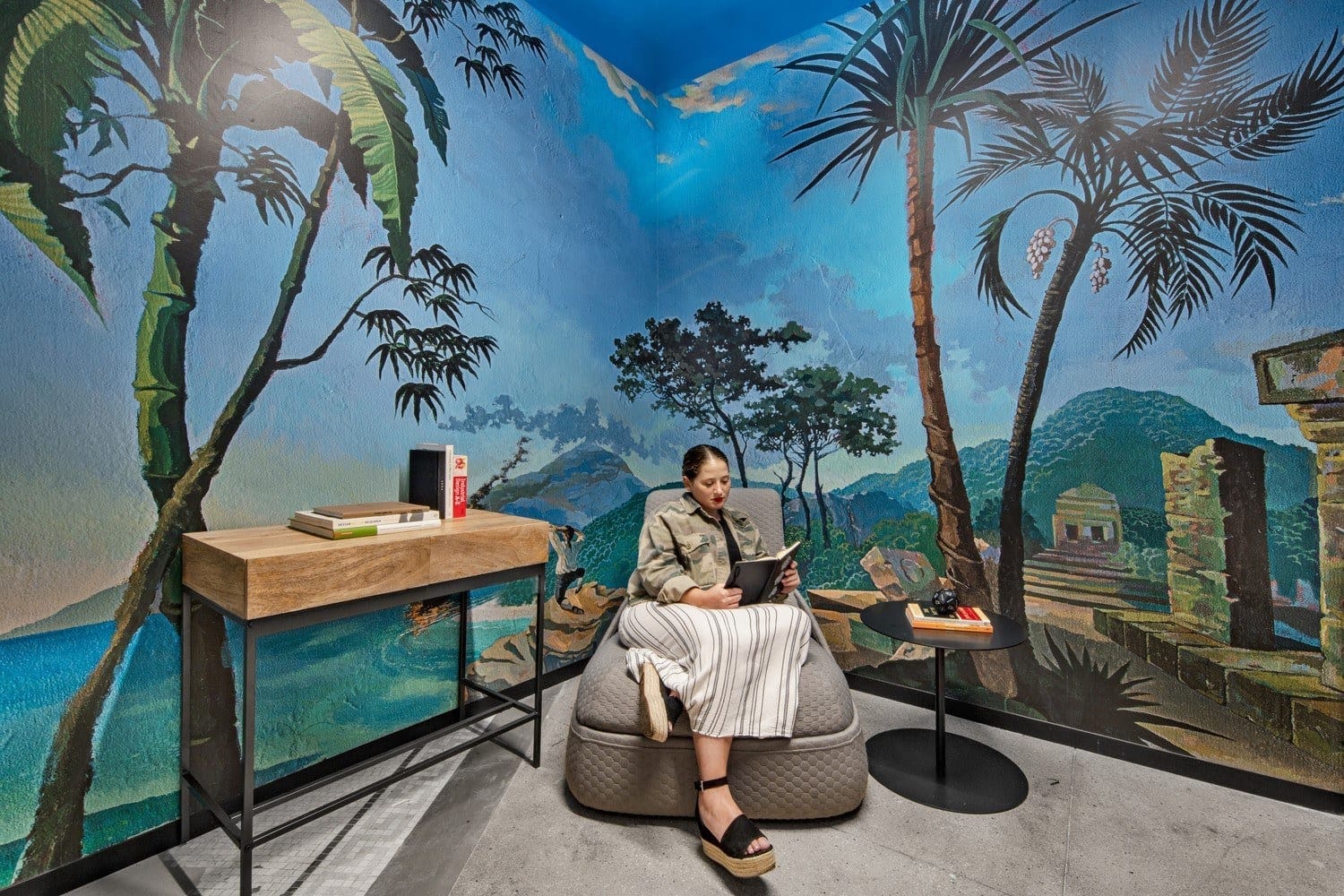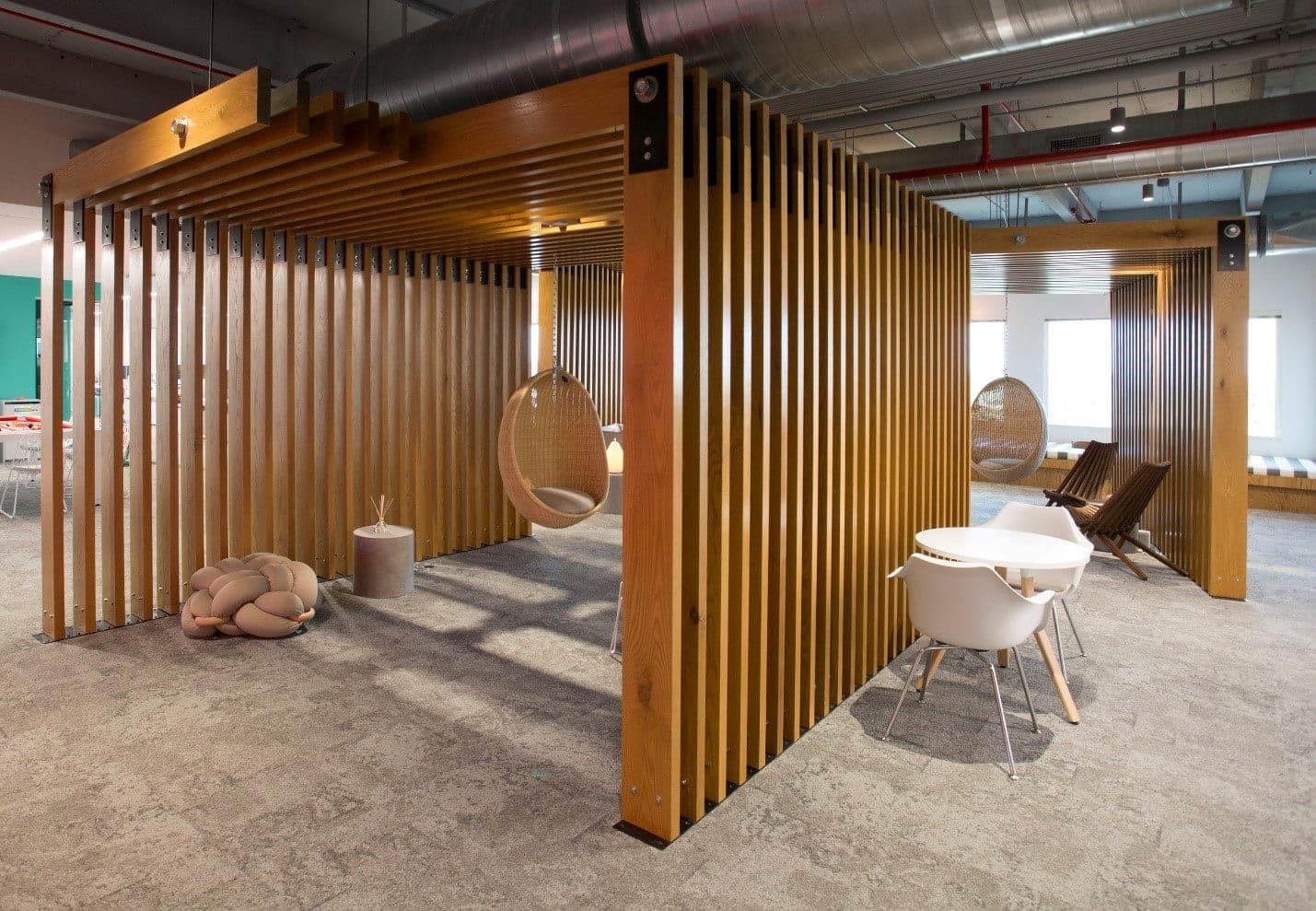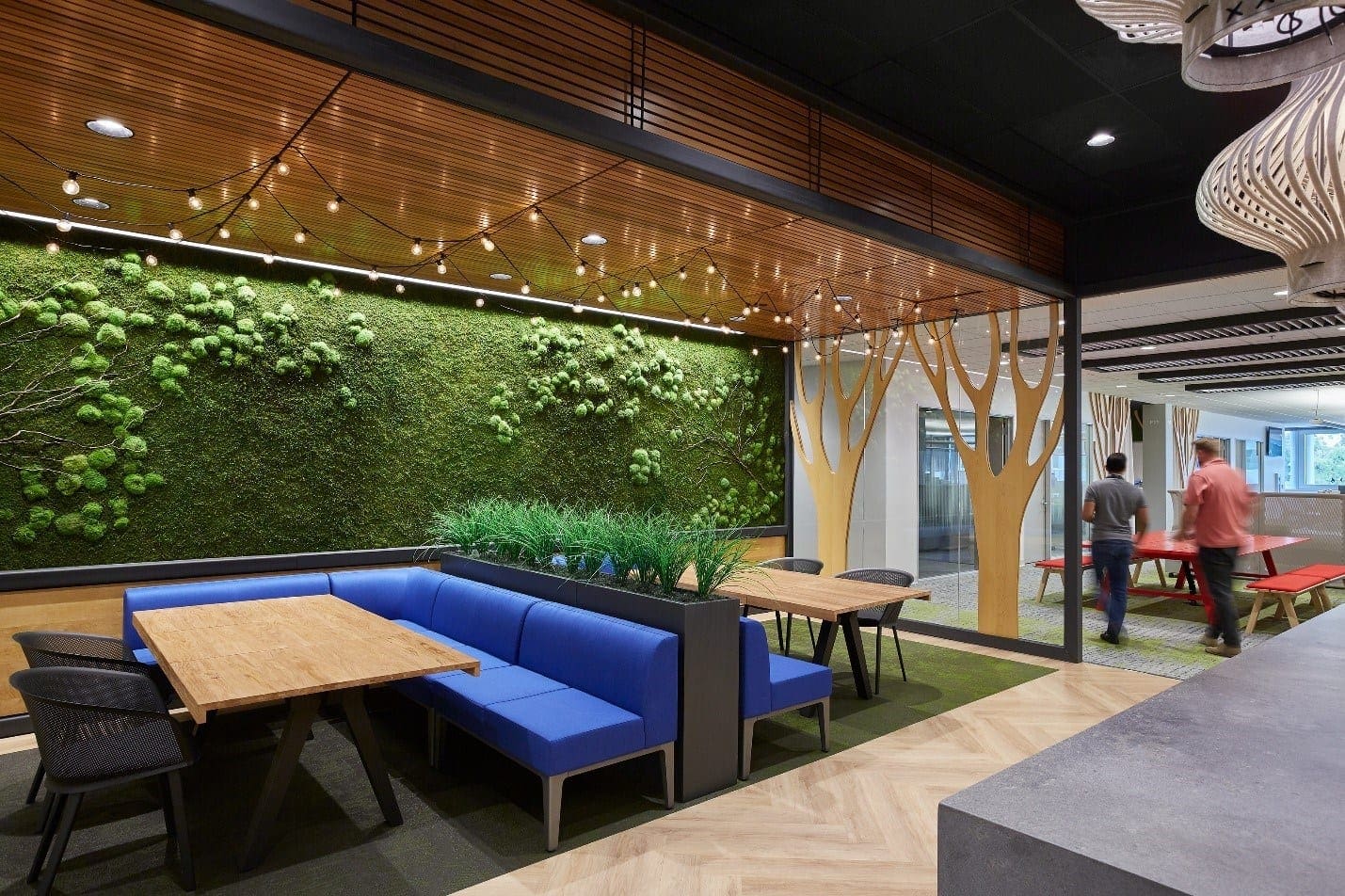Mary Lee Duff, LEED AP, IIDA | Director of Ecos Studio

Mindfulness/meditation room at IA’s New York Office. Photography © Eric Laignel.
I recently attended the Wisdom 2.0 Conference. I had seen ads, recognized the names of some of the featured speakers (Jack Kornfield, Jay Shetty, Paul Hawken, Tristan Harris, Chelsea Handler, etc.) and was intrigued. According to its founder Soren Gordhamer, “Wisdom 2.0 is a conference tackling one of the biggest challenges of today’s age: connect through technology, but do so in a way that supports a person’s well-being, work effectiveness, and is ultimately useful in the world.”
Sounds great, and is exactly what our clients have asked of IA on recent projects.
As a Senior Director of Strategy at IA, I focus on creating work environments in a digital world for optimum human experience, wellbeing, top performance, and sustainability. What I heard had a direct bearing on what I do and my on-going goal of refining how IA designs leading-edge, high performance, human-centric environments for clients.
The Attention Economy
Tristen Harris, known as the closest thing Silicon Valley has to a conscience according to a well-known article in The Atlantic, was one of the speakers. Harris spent three years as Google’s design ethicist, developing a framework to address how technology should ethically steer the thoughts and actions of billions of people from digital screens. In his opinion, technology generally fails at this. A simple example: Menus propose options—you think you’re in control and have a choice—but actually they manipulate that choice through limited, curated arrays of offerings that continue to diminish in response to your patterns or pauses and clicks.
Noting the industry’s “race to the bottom of the brain stem,” and that the use of Pavlovian techniques on the web plays to our most basic vulnerabilities, he left Google and started a non-profit, Time Well Spent, to counter what he calls the digital attention crisis and the intentional design of addictive consumer technology. Surprisingly, companies like Apple, Google, and Facebook are listening. Mark Zuckerberg has made time well spent a goal for his company and both Apple and Google have developed Digital Wellbeing initiatives with features on their phones.
Many UX (user experience) approaches to digital wellbeing focus on reminding people when they need to get away from their screens or lets them know how much time they’ve spent there. And this is where wellbeing in the workplace takes on physical proportions. In a working world where computers are the major tools to get work done, IA increasingly designs environments that give workers space to think, ponder, muse and discuss. There are a myriad of examples.
Getting Away From the Screen: Choices

An emphasis on wellness helps employees be at their best. Confidential Client, Chicago Photography © Garrett Rowland.
One of our large confidential clients requires that every floor of their many global towers have a social area with the best views of the surrounding cityscape for all to enjoy. They also require that mindfulness areas be considered for each floor, sometimes every other floor, to provide a mindfulness refuge for staff, a place to meditate with views out to the city. It’s important to note that for this client social areas and refuges are not in-board, but outward focused with natural light, increasing the wellness factor.
Getting people away from a one-to-one relationship with their digital device also means increasing opportunities for them to work in one-to-many collaborative environments, which is one of the reasons many clients today offer staff a menu of choices for where to work.
IA designed a free address engineering environment on a 120,000-sq.-ft. floorplan with a central atrium. The design relied heavily on developing small scale neighborhoods where departments could move from a primary or traditional desk seat to an array of choices to work from. The neighborhoods were buffered from one another through a variety of furniture and built elements that offer amenities such as telephone rooms, booths, team areas, huddle rooms, and open lounges. These areas also provided the secondary seating, which means that if everyone in a department shows up to work at the same time on the same day there will be a seat for them to work from.
Chief Mindfulness Officers
The growing number of chief mindfulness officers in major corporations is an indicator of the rising attention to wellness in the workplace. Wisdom 2.0 included a panel of chief mindfulness officers—moderator Rich Fernandez, formerly at Google, now CEO of Search Inside Yourself Leadership; Peter Bostelmann, founder and director of the Global Mindfulness Practice at SAP; Director of Mindfulness for Aetna Cheryl Jones; and Program Innovation Leader for the San Francisco Department of Public Health Mindfulness, Trauma and Racial Equity Jenée Johnson. Each talked about the agendas they had developed to teach mindfulness to their employees. All reported that the health of their workforce had seen a positive uptick that was also reflected in their performance and productivity along with a heightened awareness of well-being, empathy, and compassion.

Quiet spaces provide venues for inner focus. Virgin Voyages, Plantation, Florida. Photograph © Robin Hill.
When mindfulness becomes a corporate success metric, design needs to support that effort. At IA, we design mindfulness areas and rooms for our clients’ pursuit of wellness. Ensuring a balance between energized active zones for productivity and quiet zones for inner focus is a challenge. Another of our confidential clients so highly values quiet space for their global employees that they provide very carefully curated experiences for quiet and mindfulness on every floor along perimeter windows of prime real estate.
With competition for intellectual capital a daily pursuit for clients, we note that creative professionals need time to think, dream, and ponder. Often this requires a place not only to decompress but a quiet space for mindfulness and letting thoughts meander. Part of the power of the practice of mindfulness is allowing ideas to float through the mind and let them pass on—some germinating the development of great ideas that benefit the worker and the workplace.
Climate Change and Biophilia
Another aspect of wellness is a focus on making the workplace a more sustainable, carbon neutral, natural environment— an approach especially important to the millennial workforce. A leading voice in the environmental movement and an advocate for corporate reform of ecological practices, industrial ecology, and environmental policy, Paul Hawken was another speaker. He is the founder of Project Drawdown (100 solutions to reverse global warming), a non-profit dedicated to researching when and how global warming can be reversed, and a consultant to CEO’s and heads of state.
Hawken warns against using terminology normally associated with war to reference climate change because phrases like fight the war, in his opinion, suggest that we are victims. He thinks that how we communicate is obscuring brilliant solutions to climate change.
One brilliant solution, which shows a change in perception, is the idea that the workplace should both promote and reflect living in balance with nature. IA promotes biophilic design—in essence, bringing nature into the workplace to foster wellness. Biophilia suggests that people seek a connection with nature and that providing cues from nature in the workplace improves worker wellbeing.

Biophilic design elements connect users with nature. Confidential Client, Raleigh, NC. Photography © Monica Slaney.
Wellness and the Work Environment
It’s an interesting sign of our time that wellness has grown as a major movement in business operations and workplaces. It reflects a changing attitude that acknowledges quality of life as a major enabler of quality of work. In our practice at IA, we’ve been using the forward thinking now surfacing at thought leadership conferences like Wisdom 2.0 to make workplace design truly an enabler of wellness in work environments.
Enjoy This Post?
Then you'll probably enjoy another post by Mary Lee entitled "Choice Architecture: Success by Default." In it, she describes choice architecture, along with the concept of libertarian paternalism as outlined in the book Nudge: Improving Decisions about Health, Wealth, and Happiness.
